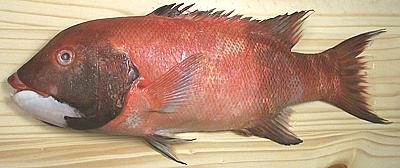 [Semicossyphus pulcher ]
[Semicossyphus pulcher ]
Found only from Monterey, California south to mid Baja California, this fish can grow to almost 36 inches and 35 pounds but the photo specimen was 16-1/2 inches and 2-1/2 pounds. The black coloration of the head and darkening tail indicates this fish was completing the transition from female to male (females are mostly red) which happens when a female reaches a length of 12 inches. This long lived slow reproducing fish is IUCN red listed as VU (Vulnerable) due to declining population.
More on the Wrass Family.
California Sheephead flesh is very white and delicate of flavor. It's also very fragile when cooked, falling into small flakes if you stare at it too hard. Fry it with at least a powdering of rice flour, or poach in modest size pieces. It's completely unsuitable for soups.
Buying: This fish is occasionally available in Asian markets here in Los Angeles, always in its male coloration. It's probably not common outside of Southern California because the fishery is tightly regulated.
Scales: This fish is covered with medium size scales that are not very hard to scrape off - but there are a whole lot of them. They are very thin and stick to everything and are invisible until they dry and curl.
Cleaning: This is not the easiest fish to clean because its internal membranes are very tough, it has a set of grinding stones in its throat (to crush hard shelled prey) and the gills don't pull easily at all. Use your kitchen shears and long nose pliers.
Filleting: this fish is not too difficult to fillet, with an easily followed bone structure - except for the ribcage, which is a problem. Fillet half way down the ribs, then cut them off with kitchen shears and pull the remaining part from the fillet with your long nose pliers, starting from the front of the fish. You'll be able to feel a row of substantial centerline pinbones for the full length of the body cavity. They pull hard. Use your long nose pliers and pull them straight forward.
Yield: For a big headed fish, yield is reasonable. A 2-3/4 pound fish yielded 1-1/4 pound of skinless fillet (45%).
Skin: The skin removes quite easily using the long knife and cutting board Method, and it must be removed. It's too strong flavored for the delicate flesh and skin shrinkage during cooking is extreme.
Stock: The head, bones and fins make a good light soup stock with moderate oil - stronger if you use the skins. Remove the oil using your gravy separator.
sf_sheepcz 061014 - www.clovegarden.com